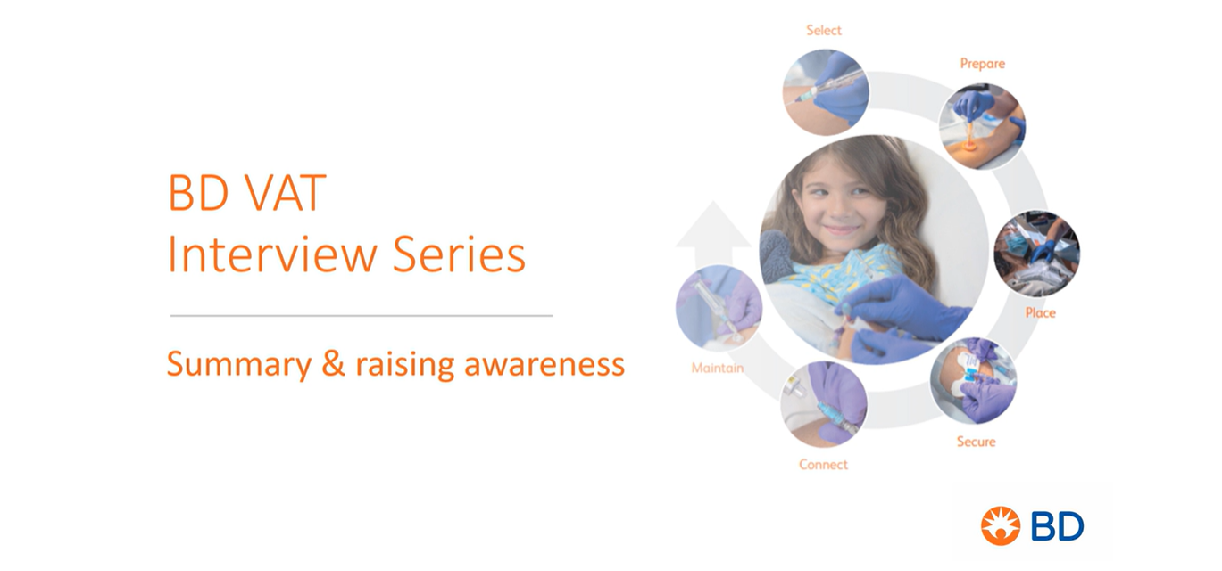Vascular Access Team (VAT) video podcast No. 5
BD vascular access team (VAT) interview series
This is the final article of the BD VAT interview series, produced in collaboration with the EU Vascular Access Management Clinical Advisory Board.
We hope you have enjoyed hearing first-hand experiences from the five VAT leaders across European hospitals featured in these interviews. Throughout the series we’ve heard their visions for VATs, the impact they believe VATs can have, barriers they’ve had to overcome and how these specialised organisations significantly impact patient outcomes.
Impact of VATs across Europe
In video No. 1, we started with a discussion about the mission of VATs, how they are structured and what kind of impact they can have across Europe.
In video No. 2, we discovered how VATs are being set up across Europe. VATs vary in size from hospital to hospital and consist of a diverse range of professionals such as nurses, anaesthetists and surgeons depending on the initial drivers for the VAT implementation.
In video No. 3, we learned that the main drivers for a VAT are to improve vascular access device (VAD) selection, placement and maintenance throughout the care continuum and to improve organisational efficiencies and reduce costs. These drivers may also help you build a solid business case of your own.
In video No. 4, we identified that VATs help reduce the burden of IV catheter-associated complications by monitoring vascular access (VA) practices and outcomes in addition to driving VA best practice guidelines and curriculums in their hospitals and abroad.
VAT leaders promote best practices in vascular care
In video No. 5, the last video in the series, we hear how VAT leads have been raising awareness throughout their practice. They also share some tips on how to support other healthcare professionals in developing their own VATs.
According to Dr Fulvio Pinelli—Anaesthesiologist and Director VA Centre, Careggi University Hospital, Florence Italy—vascular access management is becoming prominent because of clinicians’ initiatives in raising awareness and extending their skills and expertise. He notes that advancements are created from the base level, rather than top-down from the hospital management.
Noemí Cortés Rey—Nursing Supervisor, Hospital Teresa Herrera, A Coruña Spain—states that spreading best practices for VAD selection results in a holistic care approach for all patients.
Gema Munoz—Lead Vascular Access Nurse at the Royal Marsden NHS Trust, London UK—shares that once a successful model for a VAT structure has been identified, it could be shared with VA organizations and European colleagues so they can compare it with their own and choose which model fits their organisation the best.
Professor Vincent Piriou—Head of Anaesthesia and Resuscitation Department, Hospices Civils de Lyon, France—shares best practices by participating in external meetings and explains that students come to his hospital’s centre of excellence to watch VATs in action as a prerequisite to earning their university degrees. Centres of excellence like this one are a key pillar in the education of those looking to specialise and set up VATs.
Professor Baudolino Mussa—Vascular Access Surgeon and Professor of VA, University of Turin, Italy—reiterates that patients need to be at the very centre of VAT creation.
Raising awareness of vascular access teams
Despite serving specific patients at the beginning, most VATs have now developed into central services for the entire hospital due to their effectiveness.
The importance of VA is growing thanks to the involvement of clinicians in activities like congresses and educational meetings. Other initiatives such as sharing best practices and modelling successful VATs will continue to generate awareness.
Centres of excellence will educate and enable students to see the efficacy of VATs in action and allow them to proliferate VA specialisation even further. Putting the patient at the centre of all that VATs do will also increase demand for this holistic approach to patient care.
Watch the interview series finale below.
We hope this interview series has provided a useful overview of how VATs impact patient safety and satisfaction and how they have been successfully implemented across Europe.
If you missed any of the previous videos in the series, we have provided easy access for you here:
- Introduction to the series
- No. 1 Definition of a VAT, structure, and impact
- No. 2 How are VATs being set up across Europe
- No. 3 Overcoming barriers and creating a business case
- No. 4 Monitoring outcomes, learning, and looking for continuous improvement
References
BD-49933




